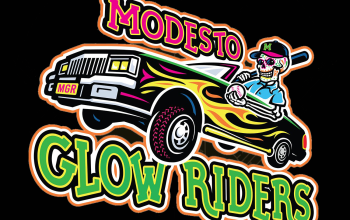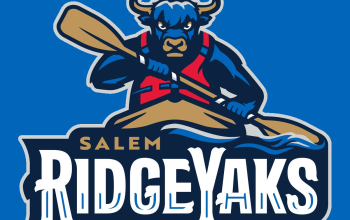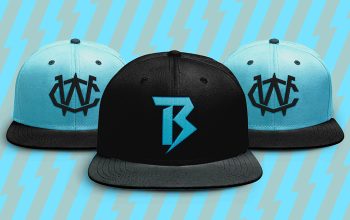The Inland Empire 66ers, an affiliate of the LA Angels and reigning champions of the single-A California League, are located in San Bernardino, California, a town noted for its place along the iconic highway Route 66. Since their inception in 2003 (they were previously the San Bernardino Stampede), the 66ers have played on their relationship with Route 66 in the most literal way possible—with a logo that looked like a highway sign.
 In a minor league baseball landscape littered with Chihuahuas and RubberDucks and Flying Squirrels, among much else, the road sign did not exactly stand out, and the team felt it was time for a change.
In a minor league baseball landscape littered with Chihuahuas and RubberDucks and Flying Squirrels, among much else, the road sign did not exactly stand out, and the team felt it was time for a change.
“We really felt one-dimensional with what we could do,” said 66ers’ general manager Joe Hudson. The team reached out to the San Diego-based firm Brandiose, which has developed new identities for lots of teams in recent years. “One of the things that we brought to Brandiose was that feeling that we wanted to be able to have fun with this thing.”
After a process that lasted about a year and a half, the team unveiled a new identity for the 2014 season. The result was a lively new primary logo—a cartoon mechanic swinging a giant wrench like a baseball bat—and perhaps a new professional record for sheer number of secondary logos. (I’ve counted seven so far, but I keep finding new ones in different places.)
While some teams have it easy, developing a look for a team named after a highway has its challenges. “It’s easy if your team name is the Grizzlies,” Hudson said. “What are you? You’re a bear! You know, the Knights. You’re the Knights!”
But the 66ers’ challenges in developing an identity were also opportunities. Hudson said, “We could have gone different routes with this thing.” [Editor’s note: SO TO SPEAK.] “The previous brand was, We’re Route 66 so we’re a road sign. We had to put a road sign on it. But that’s not necessarily the only thing…. We wanted to have our logo have a little bit of everything about Route 66. So you have the mechanic as one of the logos. You’ve got an alternate logo with a wrench, you’ve got a hood ornament as one of them, and you’ve got an engine.”
The new logo offers opportunities for the team to be creative with promotions, marketing, and scoreboard animations. “We can have more fun with it,” Hudson said. “That’s what a lot of minor league baseball is about. We’re a young front office, and we like to really have fun with what we’re doing here. The new look has definitely given us a lot more flexibility to do it.”
While the 66ers’ new look is a lot more fun and a lot more flexible than the old look, I did have one concern. I asked Hudson about the mechanic’s mechanics. That is, how do baseball people feel about the form of his swing? Hudson felt that he was not qualified to comment, so I turned to former collegiate baseball player Scott Mealey, who batted clean-up behind future Major League All Star Sean Casey at the University of Richmond in the 1990s.
 Scott said that the mechanic’s hip rotation and forearm rotation are good, but that’s about it for the positives. The biggest concern is his head. “Looking in the direction of the shortstop is not a key to success,” Scott said. “See Adam Jones’s head on any outside slider for reference.”
Scott said that the mechanic’s hip rotation and forearm rotation are good, but that’s about it for the positives. The biggest concern is his head. “Looking in the direction of the shortstop is not a key to success,” Scott said. “See Adam Jones’s head on any outside slider for reference.”
Additionally, the mechanic’s front foot should be flat on the ground, and he’s off balance. (“Inside pitch would tie him up.”) Finally, Scott said, “Teeth gritting and overall tension in the face muscles are not conducive to a loose, fast swing.”
Scott also expressed a concern that the mechanic’s bushy eyebrows would interfere with his vision and that maybe he should work out his legs at the gym every once in a while instead of just doing upper body stuff all the time.
But hey, he’s in single-A ball, right? The mechanic has time to work on his mechanics.
While the mechanic might be the team’s new identity, the face of the franchise remains their mascot Bernie, who was named 2011′s craziest mascot and has been with the team since they were the San Bernardino Stampede in the 1990s. “He’s a fan favorite and to a certain extent, he’s truly the face of our organization,” Hudson said. “So, he’s not going anywhere. It doesn’t mean that there isn’t a chance of having this new character become a sidekick kind of situation. But Bernie’s still the guy.”
While there was some early resistance to the new look (as there always is), the team’s decision to rebrand was a good one. The mechanic—even if he needs to work on his wrench-swinging form a little—and his bottomless toolkit of secondary logos will be a vital source of entertainment at the ballpark. The old street sign logo had a certain kitschy appeal (appropriate for Route 66), but the new look is unique, appropriate to the place, and most importantly—fun.














